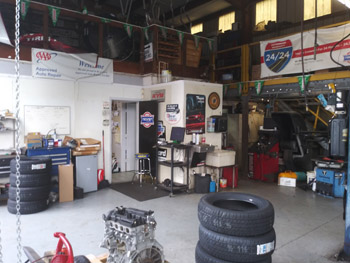All Categories
Featured

Maintaining your vehicle's tires is important to ensure a smooth, safe, and reliable driving experience. Two crucial services that are usually overlooked yet have a substantial impact on tire longevity and efficiency are tire turning and alignment. These solutions assist maintain your vehicle running efficiently and stop unequal tire wear that can affect both safety and security and gas economic situation. Allow's study what tire turning and positioning are and why they're crucial for your cars and truck.
What Is Tire Turning? Tire rotation is the procedure of relocating your tires from one position to an additional to ensure they use equally. Given that your auto's tires function at different prices depending on their position (front tires versus back tires), turning them on a regular basis aids to disperse the wear evenly, causing a much longer life-span for your tires.
Tires on the front axle tend to put on faster than those on the rear axle, particularly in front-wheel-drive cars and trucks, where the front tires handle both guiding and power. On the various other hand, rear tires may use erratically depending upon the lorry's weight circulation and driving problems. By revolving your tires every 6,000 to 8,000 miles (or as suggested by the maker), you'll ensure a much more balanced wear pattern.
What Is Tire Positioning? Tire placement, additionally known as wheel alignment, refers to changing the angles of your car's wheels to the manufacturer's specs. Appropriate positioning guarantees that your tires are aiming in the best instructions, and it aids maximize tire life and improve lorry handling. There are 3 major elements of alignment: camber, caster, and toe.
Camber describes the tilt of the tires from the front of the automobile. If your tires are tilted also much inward or external, it can create irregular wear. Wheel describes the angle of the steering axis when seen from the side of the auto. This impacts the security of the guiding, especially when driving right. Toe refers to the angle at which the tires point internal or outside when viewed from above. This impacts just how your car tracks when traveling. An appropriate alignment makes certain that all four tires are pointing directly ahead and are tilted properly. Misalignment can result from hitting holes, aesthetics, or merely from the wear of suspension parts in time.
Why Tire Rotation and Alignment Matter. Extended Tire Life. Both tire turning and positioning help stop unequal tire wear. When your tires put on uniformly, they last much longer, which can conserve you cash over time by reducing the requirement for early substitutes.
Improved Safety. Appropriate tire rotation and placement improve automobile stability and handling. Misaligned tires or erratically used tires can adversely affect your capacity to guide and stop your lorry, specifically in emergency situation circumstances. Regular upkeep guarantees your tires do efficiently, supplying a much safer driving experience.
Much Better Fuel Performance. If your tires are not lined up properly, they might drag against the roadway surface, causing resistance. This additional rubbing can minimize fuel efficiency, triggering your lorry to take in more gas. Normal tire positioning makes sure that your lorry moves successfully, improving gas mileage.
Enhanced Comfort. Misalignment or unevenly worn tires can bring about a rougher adventure, as your cars and truck may draw away or create vibrations. By maintaining your tires revolved and aligned, you'll take pleasure in a smoother and extra comfy driving experience.
Signs That Your Tires Need Turning or Placement. It's important to remain sharp for any type of indicators that your tires need rotation or alignment. Keep an eye out for these common signs:
Irregular Tire Wear: If you notice that a person tire is substantially more worn than the others, it may be time for a turning or placement. Steering Pull: If your auto pulls away while driving right, this could show misalignment. Resonances: If you feel vibrations in the steering wheel or the vehicle itself, maybe an indicator of imbalance or irregular tire wear. Screeching Tires: Uncommon tire sound might likewise show incorrect positioning or the need for a tire rotation. Just how Typically Should You Rotate and Straighten Your Tires? Tire turning must usually be done every 6,000 to 8,000 miles or as specified in your lorry's owner's handbook. It's an excellent idea to rotate your tires throughout every oil change, as this will certainly help you stay on top of normal upkeep.
As for positioning, it does not need as constant solution. Usually, positioning must be examined at the very least yearly or whenever you discover concerns like drawing away or resonance. You may additionally need alignment if you've hit a big hole or curb, which can throw your wheels out of positioning.
Conclusion: Keep Your Tires in Leading Shape. Tire rotation and positioning are essential services that maintain your lorry running smoothly, safely, and successfully. By putting in the time to have your tires turned and aligned consistently, you're buying your car's performance and long life, while additionally improving your safety on the road. Stay proactive with tire upkeep, and your vehicle will certainly thank you with far better gas economic situation, enhanced handling, and extended tire life.
Latest Posts
Don’t Miss Exclusive Auto Repair Offers in Chicago at Montclare Auto Repair
Improve Your Home's Exterior with Weathercraft's House siding Solutions
Safeguard Your Financial Investment with Professional Rain Gutter Installation
More
Latest Posts
Don’t Miss Exclusive Auto Repair Offers in Chicago at Montclare Auto Repair
Improve Your Home's Exterior with Weathercraft's House siding Solutions
Safeguard Your Financial Investment with Professional Rain Gutter Installation